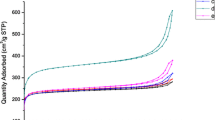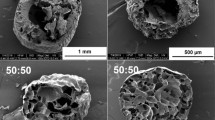Abstract
A fundamentally new low-temperature method of synthesizing ammonia has been suggested, which is carried out directly in a hydrogen-producing matrix with a material made of cellulose fabric with porous layers of ethanol–cyclam PVC derivatives with activated carbon with aquacomplexes of sodium hydroxide grafted onto its fibers. Complexes of zero-valent nickel and iron within the cyclam structure are formed in the matrix. Hydrogen is formed on the cathode in the course of electrolysis of water from sodium hydroxide aqua complexes on particles of activated carbon as microelectrodes. Hydrogen forms bonds with complexes of zero-valent nickel. Nitrogen from adsorbed air is bound in complexes of zero-valent iron and interacts with active atomic hydrogen. Water is transported to carbon particles through the fabric onto which the layer is grafted. The process is carried out at the room temperature. It has been found that the forming hydrogen is almost completely used. As opposed to the existing methods of synthesis of ammonia, the suggested process is carried out at room temperature and normal pressure.
Similar content being viewed by others
References
Semenov, V.P., Kiselev, G.F., and Orlov, A.A., Proizvodstvo ammiaka (Ammonia Production), Moscow: Khimiya, 1985.
Renner, J.N., Greenlee L.F., Ayers, K.E., and Herring, A.M., Electrochemical synthesis of ammonia: a low pressure, low temperature approach, Electrochem. Soc. Interface, 2015, vol. 24, no. 2, p. 51.
Shaver, M.P. and Fryzuk, M.D., Activation of molecular nitrogen: coordination, cleavage and functionalization of N2 mediated by metal complexes, Adv. Synth. Catal., 2003, vol. 345, p. 1061.
Fridman, A.Ya., Tsivadze, A.Yu., Morozova, E.M., Sokolova, N.P., Voloshchuk, A.M., Petukhova, G.A., Bardyshev, I.I., Gorbunov, A.M., Novikov, A.K., Polyakova, I.Ya., Titova V.N., Yavich, A.A., and Petrova, N.V., Layers of cycl-substituted PVC with sodium hydroxide aqua complexes with aza-crown ligands on cellulose tissue filled with active coal, Russ. J. Phys. Chem. A, 2016, vol. 90, no. 3, p. 641.
Fridman, A.Ya., Tsivadze, A.Yu., Sokolova, N.P., Gorbunov, A.M., and Serebryakova, N.V., Interaction of the ethanolamino groups of nanofilms with Co(II), Ni(II), Cu(II), Zn(II) and Cr(III) ammoniates at the surface of PVC plates, Russ. J. Coord. Chem., 2006, vol. 32, no. 1, p. 1.
Tsivadze, A.Yu., Fridman, A.Ya., Voloshchuk, A.M., Morozova, E.M., Sokolova, N.P., Petukhova, G.A., Bardyshev, I.I., Dorokhov, A.V., Gorbunov, A.M., Polyakova, I.Ya., Shapokhina, O.P., and Nikitin, E.V., Sorption-active nanofilms of polynuclear Ni(2+) and Ni(0) ethanol–cyclam complexes on the surface of polyvinyl chloride coating on cotton, Prot. Met. Phys. Chem. Surf., 2010, vol. 46, no. 5, p. 550.
Dorokhov, A.V., Tsivadze, A.Yu., Morozova, E.M., Sokolova, N.P., Fridman, A.Ya., Voloshchuk, A.M., Petukhova, G.A., Bardyshev, I.I., Gorbunov, A.M., Polyakova, I.Ya., Shapokhina, O.P., and Nikitin, E.V., Catalytically active porous PVC materials for sodium tetrahydridoborate decomposition in alkali solutions, Materialy XXII Vseross. simp. “Aktual’nye problemy teorii adsorbtsii, poristodti i adsorbtsionnoi selektivnosti” (Proc.12th All-Russ. Symp. on Topics in the Theory of Adsorption, Porosity, and Adsorption Selectivity), Moscow, 2008, p. 135.
Aleshina, A.L., Glazkova, S.V., Lugovskaya, L.A., Podoinikova, M.V., Fofanov, A.D., and Silina, E.V., Contemporary conceptions of the cellulose structure, Khim. Rastit. Syr’ya, 2001, no. 1, p. 5.
Kozlov, P.V., Fizika tsellulozy i ee proizvodnykh (Physics of Cellulose and Its Derivatives), Minsk: Nauka i Tekhnika, 1983.
Temkin, O.N., Chemistry of molecular nitrogen, Soros. Obraz. Zh., 1997, no. 10, p. 57.
Author information
Authors and Affiliations
Corresponding author
Additional information
Original Russian Text © A.Yu. Tsivadze, A.Ya. Fridman, N.P. Sokolova, E.M. Morozova, V.N. Titova, A.K. Novikov, A.A. Yavich, I.Ya. Polyakova, A.M. Gorbunov, I.I. Bardyshev, 2017, published in Teoreticheskie Osnovy Khimicheskoi Tekhnologii, 2017, Vol. 51, No. 2, pp. 149–152.
Rights and permissions
About this article
Cite this article
Tsivadze, A.Y., Fridman, A.Y., Sokolova, N.P. et al. Electrosynthesis of ammonia in hydrogen-producing sorption-active electrochemical matrix. Theor Found Chem Eng 51, 151–154 (2017). https://doi.org/10.1134/S0040579517020129
Received:
Published:
Issue Date:
DOI: https://doi.org/10.1134/S0040579517020129




